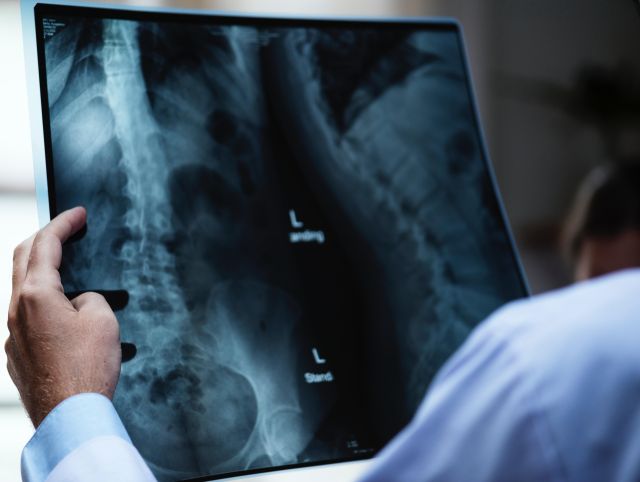Orthopedic Surgery

Orthopedic surgery aims to repair or surgically treat injuries and other illnesses of the musculoskeletal system (it includes the bones, joints, ligaments, tendons, muscles and nerves). Some conditions of the musculoskeletal system require nonsurgical procedures, while other cannot be otherwise treated.
The surgical services include:
Adult reconstructive and joint replacement surgery:
The adult reconstructive division is specialized to treat degenerative joint conditions, such as:
- Osteoarthritis - a degenerative joint disease that results in loss of cartilage tissue of the joint, leading to bones rubbing against each other.
- Rheumatoid arthritis - a condition in which the immune system attacks healthy joints. It hurts the small joints of the hands and feet, as well as larger joints, leading to inflammation and pain that limits their use.
- Avascular necrosis of the joint (osteonecrosis) - a condition caused by deprivation of blood flow resulting in necrosis (death) of the bone and the cartilage supporting it. Once the bone is “dead” the body starts to reabsorb it, leaving the joint “empty”.
The treatment includes:
- Hip replacement (hip arthroplasty) - a surgical procedure in which the damaged hip joint is removed and then replaced by a prosthetic implant. The implant can be metallic or ceramic. The procedure is usually performed on hip fractures or osteoarthritis. There could be:
- Total hip arthroplasty - in which both the femoral head (the superior part of the thigh bone - femur) and the acetabulum (the concave surface of the pelvic bone where it meets the femoral head forming the hip joint) are replaced;
- Hemiarthroplasty - only the femoral head is replaced
- Knee replacement (knee arthroplasty) - a surgical procedure in which the damaged/worn knee joint is replaced with a prosthetic implant. It is usually used to treat osteoarthritis and rheumatoid arthritis. The procedure can either be:
- Total knee arthroplasty – during the surgery both sides of the knee joint are replaced with prosthetic implants;
- Unicompartmental knee arthroplasty (partial knee replacement) - a surgical procedure, used in less severe cases, in which only one side of the joint is replaced with a prosthetic implant.
- Shoulder replacement (shoulder arthroplasty) - a surgery where the shoulder joint is replaced by a prosthetic implant. Usually performed on osteoarthritis.
Foot and Ankle surgery:
Foot and ankle division (FAD) is specialized in surgically treating these parts of the body. This branch of orthopedic surgery is in close partnership with joint disease diabetic foot and ankle surgery division. Some of the conditions that FAD treats include:
- Achilles Tendonitis (inflammation of the Achilles tendon - the tendon of the back of the leg, attached to the heel bone);
- Achilles tendon rupture;
- Ankle fractures;
- Foot and ankle arthritis;
- Foot and toe fractures;
FAD includes the following procedures:
- Ankle arthrodesis (commonly known as ankle fusion) - a surgical procedure that fuses together the ankle joint bones. The procedure aims to reduce pain in arthritic ankle that gets worse with movement.
- Ankle fracture surgery - surgical repositioning of the fractured bones, and securing them with medical screws and other hardware.
- Bunionectomy (bunion removal) - a bunion (aka hallux abducto valgus) is a deformity of the joint that connects the hallux (big toe) to the foot. It is described as the medial deviation of the first metatarsal bone (the bone in the foot just behind the hallux), and lateral deviation of the hallux. The surgery includes removing the bony bump, repositioning the bones and securing them.
- Surgical reconstruction – manipulation of neuromusculoskeletal structures in order to reconstruct deformities of the foot and ankle.
- Foot amputation - surgical removal of the foot.
Hand or upper extremity surgery:
The hand surgery division specializes in surgically treating conditions of the hand or the entire upper extremity. The conditions may be:
- Hand injuries;
- Carpal tunnel syndrome - the compression of the median nerve (one of the five main nerves of the upper limb) as it travels through the wrist at the carpal tunnel (a passageway on the palmar side of the wrist that connects the forearm to the palm);
- Carpometacarpal bossing - a small, unmovable, mass of bone on the back of the wrist;
- Rheumatoid arthritis;
- Dupuytren’s contracture (viking disease - a contracture of the hand in which the fingers bend towards the palm and cannot be fully straightened);
- Congenital defects - missing, short or abnormal number or form of the fingers, and other anomalies of the hand that are present since birth.
The procedures:
- Microsurgery - a wide number of surgical procedures mainly performed by plastic surgeons to correct some of the hand injuries which require delicate approach;
- Carpal tunnel release surgery - the procedure involves dividing the carpal ligament and decompressing the median nerve and providing relief;
- Carpometacarpal bossing surgery - excising the boss;
- Synovectomy - surgically removing the inflated synovium membrane (membrane that lines the joint). Usually performed in early stages of rheumatoid arthritis;
- Joint replacement surgery - performed on severely affected joints;
- Limited fasciectomy (LF) - a procedure that involves applying a surgical tourniquet above the operating surface to limit the blood flow, and removing the pathological tissue in the hand to treat Dupuytren’s contracture (DC);
- Wide-awake fasciectomy - as in LF, it is used to treat Dupuytren’s contracture, only the procedure is performed without the use of the tourniquet;
- Dermofasciectomy - a procedure that works with the same principle as in LF, instead, at the end of the surgery the incision is closed with a skin graft. It is used in recurrences of DC;
- Segmental fasciectomy - also used to treat DC and it involves cutting parts of the contracted cord that limits the motion of the finger;
- Reconstructive surgery - a number of surgical procedures used to correct congenital defects.
Orthopedic oncology:
OC, also known as musculoskeletal oncology, specializes in treating both malignant and benign bone and soft tissue tumors, as well as pathological fractures due to malignancy. Treatments differ depending on the size, location and stage of the cancer.
Orthopedic trauma surgery:
A wide number of surgical procedures performed on urgent cases of musculoskeletal injuries. The injuries could vary from a single fracture to multiple and life-threatening trauma of the musculoskeletal system. The procedures include:
- Repair of a fractured bone - surgical reposition of the fractured bone, with the use of medical screws to stabilize it;
- Repair of the soft tissue damage - surgical procedures that restore the normal function of the ligaments, tendons and muscle after a traumatic injury;
- Osteomyelitis surgery (OS) - osteomyelitis is an infection of the bone and bone marrow. OS is performed on cases that could not be otherwise treated and it involves removing the diseased part of the bone, and then using plates and screws to secure the bones in their new position. In severe cases where the damaged part of the bone is bigger, and the condition could not be treated otherwise, the affected limb may be amputated.
Pediatric orthopedic surgery:
The pediatric orthopedic division treats the musculoskeletal conditions of infants, children and adolescents.
Some of the most common pediatric orthopedic conditions:
- Hip dysplasia (hip dislocation) - congenital or developmental misalignment of the hip joint. The surgical treatment involves repairing and repositioning the joint and sometimes - hip replacement;
- Clubfoot (congenital talipes equinovarus) - congenital deformity of the foot that makes it look like the ankle revolved internally. Surgical correction treatment is used when other methods were ineffective.
- Different limb length. Surgical treatment involves several techniques to correct this discrepancy.
- Scoliosis - a deformity of the curvature of the spine. The surgical treatment is used only if other corrective methods did not succeed and the condition is severe.
- Sports injuries - some of them require surgical treatment.
Spine medicine: a branch of both orthopedic surgery and neurosurgery that treats diseases and deformities of the spine.
Sports medicine: a branch of orthopedic surgery aiming to treat sport injuries.
Providers that provide Orthopedic Surgery Service
| Providers | Score | Reviews | Location |
|---|---|---|---|
| Ponderas Hospital |
Not Rated |
0 | Romania |
| Precision Pain Medicine |
Not Rated |
0 | United States |
| Premier Podiatry |
Not Rated |
1 | United States |
| Promea S.p.A. |
Not Rated |
0 | Italy |
| QC Kinetix Edmond |
Not Rated |
0 | United States |
| Redefine Healthcare - Hackensack, NJ |
Not Rated |
0 | United States |
| Repromed |
Not Rated |
0 | Moldova |
| Shemer Medical Center |
Not Rated |
0 | Israel |
| Vascular Surgeon in India - Devadoss Hospital |
Not Rated |
0 | India |
| Acibadem Healthcare Group |
Not Rated |
1 | Turkey |
| Hospital Britanico |
Not Rated |
1 | Argentina |
| Kims Al Shifa |
Not Rated |
1 | India |
| KOLAN BRITISH HOSPITAL |
Not Rated |
0 | Cyprus |
| Policlinico Universitario Campus Bio-Medico |
Not Rated |
0 | Italy |
| Aastha Kidney And Super Specialty Hospital |
Not Rated |
0 | India |
| Abbott Northwestern Hospital |
Not Rated |
0 | United States |
| Abington Memorial Hospital |
Not Rated |
0 | United States |
| Abris Medical Center Llc |
Not Rated |
0 | United Arab Emirates |
| Academic Hospital |
Not Rated |
0 | Turkey |
| Adiva |
Not Rated |
0 | India |

